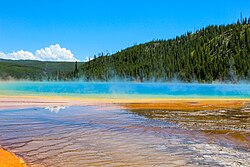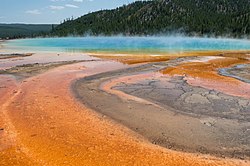| Grand Prismatic Spring | |
|---|---|
 Aerial view of the Grand Prismatic Spring | |
 | |
| Location | Midway Geyser Basin, Yellowstone National Park, Teton County, Wyoming |
| Coordinates | 44°31′30″N110°50′17″W / 44.52500°N 110.83806°W [1] |
| Elevation | 7,270 ft (2,220 m) [2] |
| Type | Hot spring |
| Discharge | 560 US gal (2,100 L) per minute |
| Temperature | 160 °F (70 °C) |
| Depth | 160 ft (50 m) |
The Grand Prismatic Spring in Yellowstone National Park is the largest hot spring in the United States, and the third largest in the world, [3] after Frying Pan Lake in New Zealand and Boiling Lake in Dominica. It is located in the Midway Geyser Basin.
Contents
Grand Prismatic Spring was noted by geologists working in the Hayden Geological Survey of 1871, and named by them for its striking coloration. Its colors match most of those seen in the rainbow dispersion of white light by an optical prism: red, orange, yellow, green, and blue. [4]


